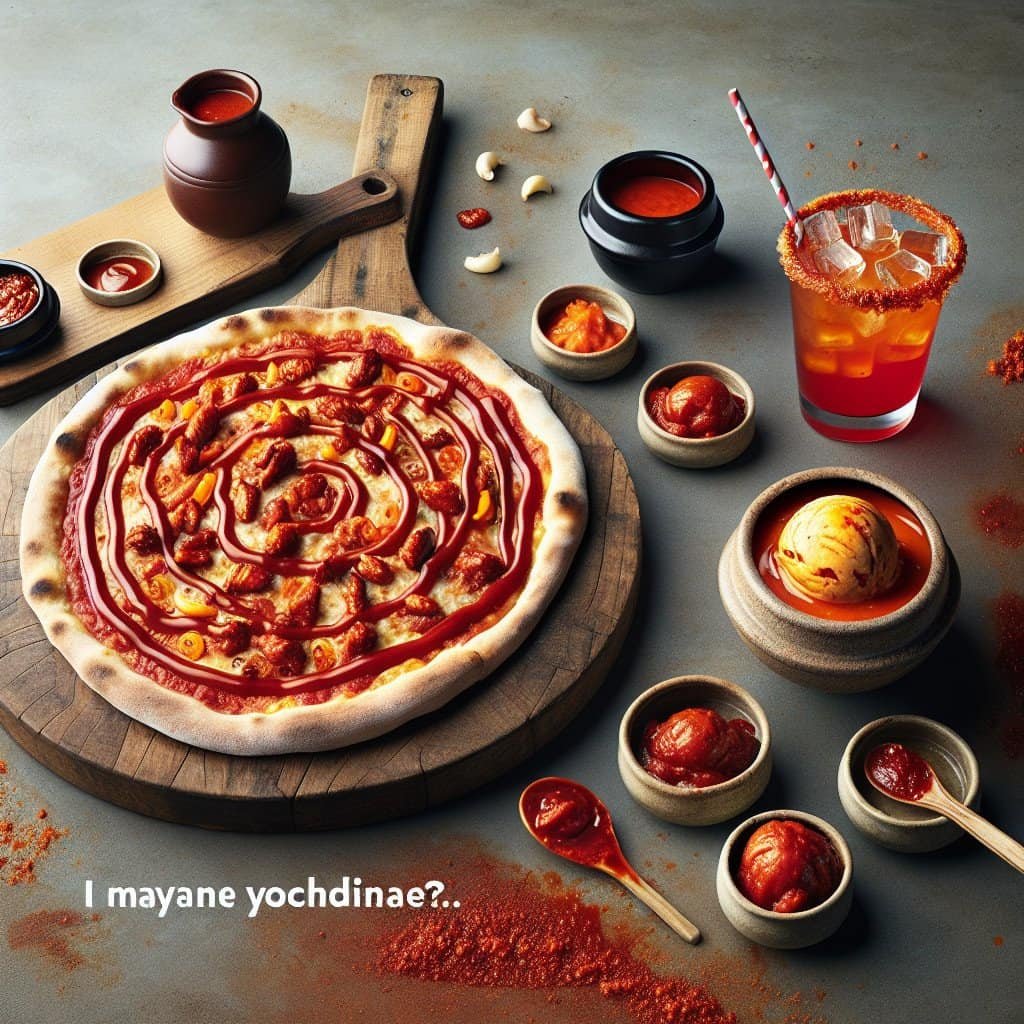Are you tired of using gochujang solely in traditional Korean dishes? Well, get ready to discover a whole new world of flavor! In this article, we’ll explore some creative ways to incorporate gochujang into non-traditional dishes. From spicy gochujang marinades for grilled meats to gochujang-infused dressings for salads, we’ll show you how to elevate your meals with this delicious and versatile ingredient. So, get ready to give your taste buds a delightful surprise and let’s explore the exciting world of gochujang together!

Gochujang in Appetizers
Spicy Gochujang Deviled Eggs
If you’re looking for a spicy twist on a classic appetizer, look no further than spicy gochujang deviled eggs. The creamy texture of the egg yolk mixed with the heat from gochujang creates a unique and delicious flavor combination. Simply peel hard-boiled eggs, cut them in half, and remove the yolks. Mash the yolks with mayonnaise, gochujang, and a touch of mustard. Pipe the mixture back into the egg whites and garnish with a sprinkle of paprika or sliced green onions. Your guests will be impressed by this spicy spin on a party favorite!
Gochujang Shrimp Skewers
Gochujang shrimp skewers are another appetizer option that packs a flavor punch. Marinate shrimp in a mixture of gochujang, soy sauce, minced garlic, honey, and lime juice for at least 30 minutes. Thread the marinated shrimp onto skewers and grill them until they become pink and opaque. The gochujang adds a spicy and tangy element to the shrimp, making them a crowd-pleasing appetizer for any occasion.
Gochujang Bruschetta
Bruschetta is a popular Italian appetizer, but why not give it a Korean twist with gochujang? Start by toasting slices of baguette or Italian bread until they are crisp and golden. In a bowl, mix diced tomatoes, minced garlic, chopped basil, olive oil, salt, pepper, and a spoonful of gochujang. Spread the gochujang mixture onto the toasted bread slices and serve them as a unique and flavorful appetizer. The blend of the traditional tomato mixture with the spicy kick of gochujang will leave your taste buds wanting more.
Gochujang in Salads
Spicy Gochujang Coleslaw
Take your coleslaw to the next level by adding a spicy gochujang twist. In a large bowl, combine shredded cabbage, grated carrots, sliced green onions, chopped cilantro, and toasted sesame seeds. In a separate bowl, whisk together mayonnaise, gochujang, apple cider vinegar, honey, soy sauce, and a touch of lime juice. Pour the dressing over the cabbage mixture and toss until well coated. The gochujang adds a spicy kick to the creamy coleslaw, making it a standout side dish for any meal or gathering.
Gochujang Caesar Salad Dressing
For a unique twist on a classic Caesar salad, try incorporating gochujang into the dressing. In a blender or food processor, combine garlic, anchovy paste, Dijon mustard, Worcestershire sauce, lemon juice, grated Parmesan cheese, gochujang, and olive oil. Blend until smooth and creamy. Toss the dressing with chopped romaine lettuce, croutons, and additional Parmesan cheese for a flavorful and spicy Caesar salad. The gochujang adds a bold and vibrant flavor to this traditional favorite.
Gochujang Avocado Salad
Avocado salads are already delicious, but adding gochujang takes them to a whole new level. Start by slicing ripe avocados and arranging them on a bed of mixed greens or spinach. In a small bowl, whisk together gochujang, lime juice, honey, and olive oil to create a spicy dressing. Drizzle the dressing over the avocado and greens, and top with toasted sesame seeds and chopped green onions. The combination of creamy avocado and spicy gochujang creates a salad that is bursting with flavor, making it a perfect option for a light lunch or side dish.

Gochujang in Sandwiches and Wraps
Gochujang Chicken Sandwich
Elevate your chicken sandwich game by adding gochujang for a spicy kick. Start with cooked chicken breast, either grilled or roasted, and thinly slice it. Toast a bun or bread of your choice and spread a generous amount of gochujang mayo on both sides. Layer the sliced chicken on the bottom half of the bun and top with lettuce, tomato, and thinly sliced red onion. The gochujang mayo adds heat and tanginess to the sandwich, transforming it into a flavorful and satisfying meal.
Korean Beef Wrap with Gochujang Mayo
Create a fusion of flavors with a Korean beef wrap featuring gochujang mayo. Marinate thinly sliced beef in a mixture of soy sauce, sesame oil, minced garlic, grated ginger, brown sugar, and gochujang. Cook the marinated beef in a hot skillet until it reaches your desired level of doneness. Spread a generous amount of gochujang mayo on a tortilla or wrap, then add the cooked beef, thinly sliced cucumber, shredded carrots, and chopped green onions. Roll up the wrap and enjoy the combination of tender beef and spicy gochujang mayo.
Vegetable Gochujang Wrap
For a vegetarian option, try a vegetable gochujang wrap filled with fresh and flavorful ingredients. Start by sautéing a mix of colorful vegetables such as bell peppers, zucchini, and mushrooms in a hot skillet with a drizzle of sesame oil. In a small bowl, mix gochujang with a splash of soy sauce, honey, and rice vinegar to create a tangy dressing. Spread the gochujang dressing on a tortilla or wrap, then add the sautéed vegetables, cooked quinoa or rice, and fresh herbs such as cilantro or basil. Roll up the wrap and enjoy a burst of spicy and savory flavors.
Gochujang in Marinades and Sauces
Spicy Gochujang BBQ Marinade
Take your barbecue game up a notch with a spicy gochujang marinade. In a bowl, whisk together gochujang, soy sauce, brown sugar, minced garlic, sesame oil, and a touch of apple cider vinegar. Place your choice of meat, such as chicken, beef, or pork, in a zip-top bag and pour the marinade over it. Allow the meat to marinate in the refrigerator for at least 2 hours or overnight for maximum flavor. Grill the marinated meat until cooked to perfection, and brush with additional gochujang sauce while grilling for an extra layer of heat and sweetness.
Gochujang Glaze for Grilled Vegetables
Grilled vegetables are delicious on their own, but adding a gochujang glaze takes them to a whole new level. In a small saucepan, combine gochujang, honey, soy sauce, minced garlic, and water. Heat the mixture over low heat until the ingredients are well combined and the sauce has thickened slightly. Brush the gochujang glaze onto your favorite grilling vegetables, such as bell peppers, zucchini, and eggplant, and grill until tender and slightly charred. The gochujang glaze adds a spicy and sweet element that complements the smoky flavors of the grilled vegetables.
Gochujang Dipping Sauce
Create a versatile and spicy gochujang dipping sauce for a variety of dishes. In a small bowl, whisk together gochujang, rice vinegar, soy sauce, honey, minced garlic, and a touch of sesame oil. Adjust the amounts of each ingredient to suit your personal taste preferences, adding more honey for sweetness or gochujang for a spicier kick. This dipping sauce pairs well with appetizers such as dumplings, spring rolls, or chicken wings. The combination of flavors in the gochujang dipping sauce adds depth and complexity to any dish.

Gochujang in Stir-Fries
Spicy Gochujang Beef Stir-Fry
Add a fiery kick to your stir-fries with a spicy gochujang beef stir-fry. Slice beef thinly and marinate it in a mixture of soy sauce, gochujang, grated ginger, minced garlic, and a touch of honey. In a hot skillet or wok, stir-fry the marinated beef until cooked to your desired level of doneness. Add a mix of vegetables such as bell peppers, broccoli, and carrots, and continue stir-frying until the vegetables are tender-crisp. Serve the spicy gochujang beef stir-fry over rice or noodles for a satisfying and flavorful meal.
Gochujang Tofu Stir-Fry
For a vegetarian stir-fry option, try gochujang tofu stir-fry. Drain and press tofu to remove excess moisture, then cut it into bite-sized cubes. In a bowl, combine gochujang, soy sauce, rice vinegar, sesame oil, minced garlic, and a touch of honey. Toss the tofu in the gochujang marinade and let it sit for at least 30 minutes to absorb the flavors. In a hot skillet or wok, stir-fry the marinated tofu until it becomes golden brown and slightly crispy. Add a colorful mix of vegetables such as snow peas, mushrooms, and bok choy, and stir-fry until the vegetables are tender. The gochujang marinade adds a spicy and savory flavor to the tofu and vegetables, making this dish a vegetarian delight.
Gochujang Shrimp Stir-Fry
If you’re a fan of seafood, a gochujang shrimp stir-fry is a must-try. In a bowl, mix gochujang, soy sauce, minced garlic, grated ginger, honey, and lime juice to create a spicy marinade. Toss raw shrimp in the marinade and let it sit for at least 15 minutes. In a hot skillet or wok, stir-fry the marinated shrimp until they turn pink and opaque. Add a combination of colorful vegetables such as bell peppers, snap peas, and carrots, and continue stir-frying until the vegetables are crisp-tender. The gochujang marinade adds a vibrant and spicy flavor to the shrimp, resulting in a delicious and satisfying stir-fry.
Gochujang in Soups and Stews
Spicy Gochujang Ramen Soup
Upgrade your bowl of ramen with a spicy gochujang ramen soup. Prepare your choice of ramen noodles according to the package instructions and set aside. In a pot, sauté minced garlic and grated ginger in a drizzle of sesame oil until fragrant. Add chicken or vegetable broth, gochujang, soy sauce, and a touch of honey to the pot and bring to a simmer. Add cooked ramen noodles and your choice of protein such as shredded chicken or tofu. Top the soup with sliced green onions, soft-boiled eggs, and kimchi for extra flavor and texture. The gochujang adds a spicy and savory element to the ramen soup, making it a comforting and satisfying meal.
Korean Army Stew with Gochujang
Korean Army Stew, also known as Budae Jjigae, is a hearty and flavorful stew that originated during the Korean War. To make this classic dish with a twist, start by bringing a pot of chicken or vegetable broth to a boil. Add gochujang, soy sauce, minced garlic, and grated ginger to the broth and simmer for a few minutes. Add an assortment of ingredients such as sliced sausage, bacon, spam, canned baked beans, instant ramen noodles, sliced tofu, and a variety of vegetables such as cabbage, mushrooms, and kimchi. Simmer the stew until the ingredients are cooked and the flavors meld together, creating a robust and spicy stew that will warm you up on a chilly day.
Gochujang Miso Soup
Combine Japanese and Korean flavors with a gochujang miso soup. In a pot, bring water to a boil and whisk in miso paste until dissolved. Add diced tofu, sliced green onions, and finely chopped seaweed to the pot and simmer for a few minutes. In a separate bowl, mix gochujang with a splash of soy sauce, rice vinegar, and sesame oil to create a spicy gochujang sauce. Ladle the miso soup into bowls and drizzle the gochujang sauce over the top. The gochujang adds a spicy kick to the traditional miso soup, creating a bold and unique flavor combination.

Gochujang in Rice and Noodle Dishes
Gochujang Fried Rice
Make your fried rice extra special with the addition of gochujang. In a hot skillet or wok, sauté diced vegetables such as bell peppers, carrots, peas, and corn until they become tender. Push the vegetables to one side of the skillet and crack eggs into the empty space. Scramble the eggs until cooked, then mix them with the vegetables. Add cooked rice to the skillet and stir-fry until everything is well combined. In a small bowl, whisk together gochujang, soy sauce, sesame oil, honey, and a touch of rice vinegar. Pour the gochujang sauce over the fried rice and continue stir-frying until the rice is evenly coated. The gochujang sauce adds a spicy and savory flavor to the fried rice, making it a delicious and satisfying meal on its own or as a side dish.
Spicy Gochujang Noodles
For a quick and flavorful noodle dish, try spicy gochujang noodles. Cook your choice of noodles, such as udon, soba, or ramen, according to the package instructions. In a small bowl, whisk together gochujang, soy sauce, rice vinegar, honey, minced garlic, and sesame oil to create a spicy sauce. Drain the cooked noodles and toss them in the gochujang sauce until evenly coated. Garnish with sliced green onions and toasted sesame seeds for added flavor and texture. The gochujang sauce adds a spicy and hearty element to the noodles, making it a satisfying and delicious meal.
Gochujang Bibimbap
Bibimbap is a popular Korean rice dish that can be customized with your favorite toppings. Start by cooking rice according to the package instructions and set it aside. Sauté a mix of colorful vegetables such as spinach, carrots, zucchini, bean sprouts, and mushrooms until they become tender. In a separate bowl, mix gochujang with a splash of soy sauce, sesame oil, honey, and rice vinegar to create a spicy gochujang sauce. Arrange the cooked rice in a bowl, then top with the sautéed vegetables and a fried egg. Drizzle the gochujang sauce over the top and mix everything together before enjoying. The gochujang sauce adds a spicy and tangy flavor to the bibimbap, creating a satisfying and filling meal.
Gochujang in Meat and Seafood
Gochujang Glazed Pork Tenderloin
Impress your guests with a gochujang glazed pork tenderloin that is packed with flavor. In a small bowl, whisk together gochujang, soy sauce, honey, grated ginger, minced garlic, and a touch of brown sugar. Rub the gochujang glaze all over the pork tenderloin and let it marinate for at least 30 minutes. Preheat your grill or oven to medium-high heat and cook the pork tenderloin until it reaches an internal temperature of 145°F (63°C). Brush additional gochujang glaze over the cooked tenderloin before slicing and serving. The gochujang glaze adds a sweet and spicy element to the tender and juicy pork, making it a standout dish for any occasion.
Spicy Gochujang Chicken Wings
Spice up your chicken wings with a gochujang marinade that will have everyone reaching for seconds. In a bowl, mix gochujang, soy sauce, honey, minced garlic, grated ginger, and a touch of rice vinegar. Add chicken wings to the bowl and toss them in the marinade until they are well coated. Let the wings marinate in the refrigerator for at least 1 hour or overnight for maximum flavor. Preheat your oven or grill to medium-high heat and cook the marinated wings until they are crispy and golden brown. Serve the wings with a side of gochujang dipping sauce for an extra spicy kick. The gochujang marinade adds a fiery and savory flavor to the crispy chicken wings, making them a crowd-pleasing appetizer or main dish.
Gochujang Salmon
Elevate your salmon with a gochujang glaze that adds a spicy and sweet kick. In a small bowl, whisk together gochujang, soy sauce, honey, minced garlic, grated ginger, and a touch of sesame oil. Brush the gochujang glaze over salmon fillets and let them marinate for at least 30 minutes. Preheat your oven or grill to medium-high heat and cook the glazed salmon until it becomes flaky and opaque. Serve the gochujang-glazed salmon with a squeeze of fresh lime juice and a sprinkle of chopped green onions for a burst of brightness. The gochujang glaze adds a complex and delicious flavor to the salmon, making it a standout dish for any seafood lover.

Gochujang in Vegetarian and Vegan Dishes
Gochujang Cauliflower Bites
For a vegetarian take on spicy buffalo wings, try gochujang cauliflower bites. Start by cutting cauliflower into bite-sized florets and tossing them in a mixture of gochujang, soy sauce, minced garlic, and a touch of honey. Spread the marinated cauliflower on a baking sheet and roast in the oven until they become crispy and slightly caramelized. Serve the gochujang cauliflower bites with a side of ranch or blue cheese dressing for dipping. The gochujang adds a spicy and tangy flavor to the crispy cauliflower, making it a satisfying alternative to traditional buffalo wings.
Korean Tofu with Gochujang
Transform tofu into a flavorful and spicy dish with Korean-inspired flavors. Start by pressing and draining firm tofu to remove excess moisture. Cut the tofu into cubes and pan-fry them until they become golden brown and slightly crispy. In a small bowl, whisk together gochujang, soy sauce, sesame oil, minced garlic, grated ginger, and a touch of brown sugar. Toss the crispy tofu in the gochujang sauce until evenly coated. Serve the Korean gochujang tofu with a side of steamed rice and steamed vegetables for a complete and satisfying meal. The gochujang sauce adds a spicy and savory element to the crispy tofu, making it a versatile and delicious dish for vegetarians and vegans alike.
Gochujang Veggie Burger
Take your veggie burger to the next level with a gochujang twist. In a food processor, pulse cooked lentils, cooked quinoa, breadcrumbs, mashed sweet potato, chopped onion, minced garlic, gochujang, soy sauce, and your choice of spices until well combined. Shape the mixture into patties and cook them on a grill or stovetop until they become browned and crispy. Serve the gochujang veggie burgers on a bun with your favorite toppings, such as lettuce, tomato, and avocado. The gochujang adds a spicy and savory flavor to the veggie burger, making it a standout option for vegetarians and vegans.
Gochujang in Desserts
Spicy Gochujang Chocolate Truffles
If you’re a fan of sweet and spicy flavors, try making gochujang chocolate truffles. In a bowl, melt dark chocolate and mix it with a spoonful of gochujang. Stir until the gochujang is evenly incorporated into the chocolate. Let the mixture cool slightly, then shape it into small truffle balls. Roll the truffle balls in cocoa powder or chopped nuts for added texture. Chill the truffles in the refrigerator until firm, then indulge in the spicy and rich flavors of these unique and decadent treats.
Gochujang Caramel Sauce
Add a spicy kick to your caramel sauce by incorporating gochujang. In a saucepan, combine sugar, water, and corn syrup, and cook over medium heat until the sugar dissolves and the mixture turns golden brown. Remove the saucepan from the heat and whisk in gochujang, heavy cream, and a touch of salt. Return the saucepan to low heat and cook for a few more minutes until the caramel sauce thickens slightly. Let the gochujang caramel sauce cool before drizzling it over ice cream, pancakes, or any other dessert of your choice. The gochujang adds a spicy and complex flavor to the rich and creamy caramel sauce, creating a truly unforgettable taste.
Gochujang Popsicles
Cool down on a hot day with spicy gochujang popsicles. In a blender, combine fresh fruit such as mango, pineapple, or strawberries with coconut milk, honey, and a spoonful of gochujang. Blend until smooth and creamy. Pour the mixture into popsicle molds and freeze until solid. The gochujang adds a spicy and tangy element to the refreshing fruit flavors, creating a unique and delicious popsicle that will keep you cool all summer long.
In conclusion, gochujang has become a versatile ingredient that can be used in a wide variety of non-traditional dishes. Whether you’re looking to add a spicy kick to appetizers, salads, sandwiches, marinades, stir-fries, soups, rice and noodle dishes, meat and seafood, vegetarian and vegan dishes, or even desserts, gochujang can elevate your recipes to new heights. With its bold and complex flavor profile, gochujang adds a unique and delicious twist to every dish it touches. So go ahead and experiment with this Korean chili paste, and let your culinary creativity soar!
